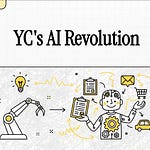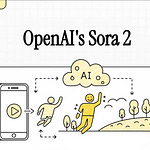Introduction: A Strategic Overview
This document provides a strategic examination of select startups from Y Combinator’s 2025 AI cohort, focusing on three critical sectors: Healthcare, Finance, and Developer Tools. The analysis moves beyond a simple listing of companies to deliver a nuanced comparison of their distinct business models, target customers, and core technologies. By dissecting the competitive dynamics and emerging market trends within these verticals, this report aims to furnish business development professionals and market researchers with actionable insights into the evolving AI landscape.
1. The AI Healthcare Revolution: Automation, Diagnostics, and Discovery
1.1. Context and Strategic Importance
The healthcare industry is at a critical inflection point, where the adoption of AI is no longer an option but a strategic necessity for survival and growth. The sector is aggressively deploying AI to address its two most significant and costly challenges: crushing administrative overhead and the complex, data-intensive processes of diagnostics and drug discovery. The startups emerging from Y Combinator reflect this dual focus, with one cohort building solutions to automate costly manual workflows and another developing deep-tech platforms to fundamentally advance medical science. This section analyzes how these companies are positioned to capture value by either optimizing the current healthcare system or inventing the next generation of medical technology.
1.2. Automating the Point of Care: The Rise of AI Medical Staff
A prominent group of startups is focused on automating the clinical and administrative tasks that consume a significant portion of healthcare professionals’ time and organizations’ budgets. These companies are not merely building tools but are positioning their AI as autonomous agents or “employees” capable of executing entire workflows.
Company
Core AI Application
Stated Value Proposition & Target Customer
Sully.ai
AI Medical Employees
Value Prop: Performs tasks 20x cheaper & 10x faster than human staff. <br> Target:Healthcare organizations with 100+ employees.
Prosper
AI Phone Agents
Value Prop: Aims to eliminate the $200B lost annually to administrative overhead by reducing costs 50% and tripling productivity. <br> Target: Healthcare providers, leveraging deep integration with EHR systems.
Health Harbor
Generative AI for Insurance Calls
Value Prop: Saves clinics up to 40 hours of phone calls per week with a 24-hour turnaround. <br> Target: Healthcare clinics.
Vetnio
AI Administrative Automation
Value Prop: Aims to free veterinarians from the 40% of their time spent on administrative work, particularly note-taking. <br> Target: Veterinarians.
1.3. Deep Tech in Healthcare: AI for Diagnostics and Therapeutics
Moving from operational efficiency to core medical innovation, another set of companies is applying AI to solve fundamental challenges in biotechnology and diagnostics. Their focus is on leveraging complex datasets to detect diseases earlier, design novel therapies, and combat existential threats like antibiotic resistance.
Company
Technological Focus
Target Medical Challenge
BrainKey
Analysis of brain MRI and biomedical data
Dementia and cognitive decline, empowering physicians to detect and prevent brain longevity challenges.
Darmiyan
Novel quantitative virtual microscopy from non-invasive MRI data
Early detection of Alzheimer’s disease.
Cleancard
Synthetic biology and AI to enable diagnostics from urine
Developing at-home, 30-minute tests for cancer detection.
WhiteLab Genomics
AI platform for genomic therapy design
Accelerating the discovery and design of advanced treatments like Cell, RNA, and DNA therapies.
Evolvere BioSciences
Computational models to forecast bacterial mutations
Creating “future-proof” antibiotics to address the growing crisis of antibiotic resistance.
1.4. Sector Analysis and Forward Outlook
The key competitive battleground in YC’s AI healthcare cohort is defined by a strategic bifurcation into workflow automation and deep-tech discovery. This split creates two distinct go-to-market challenges and risk profiles. The automation players, such as Sully.ai, compete on immediate, demonstrable ROI. Their sales cycle is geared towards hospital administrators, promising rapid cost savings and efficiency gains with a relatively low-risk, operational expenditure. Conversely, deep-tech companies like Evolvere BioSciences compete on scientific breakthroughs and the potential to create new standards of care. Their path to market is long, capital-intensive, and fraught with scientific and regulatory risk, involving lengthy FDA approval processes and strategic partnerships with major pharmaceutical companies. The strategic implication is a market that is simultaneously absorbing near-term operational optimizations while placing long-term bets on fundamental medical innovation. As we will see, similar themes of operational automation and sophisticated risk management are just as prevalent in the financial sector.
2. AI in Finance & Compliance: Redefining Risk, Lending, and Operations
2.1. Context and Strategic Importance
AI is forcing a fundamental re-architecture of the financial services industry, moving well beyond incremental efficiency gains. A new wave of startups is using artificial intelligence to automate high-stakes functions that were previously the exclusive domain of human experts. From regulatory compliance and fraud detection (RegTech) to loan origination and core back-office accounting, AI is enabling companies to automate complex, judgment-based work at an unprecedented scale.
2.2. The RegTech Vanguard: Automating Compliance and Due diligence
The RegTech space reveals a key strategic tension between end-to-end platforms and task-specific assistants. This is clearly illustrated by the competitive positioning of Flagright and Diligent.
• Flagright operates as an end-to-end platform, offering fintechs and banks a comprehensive AML compliance software solution. It is designed to automate the entire workflow of transaction monitoring, screening, and reporting, allowing clients to scale transaction volume without scaling their compliance headcount.
• Diligent positions itself as a task-specific AI assistant for fintech risk and AML compliance teams. Its LLM-powered agents focus on automating routine customer due diligence tasks—such as reviewing registry extracts or remediating false positive alerts—to free up human experts for higher-value investigations.
2.3. Transforming Lending and Underwriting
Another significant cluster of companies is targeting the lending value chain, applying AI to streamline and automate processes across various asset classes, from small business loans to consumer mortgages.
Company
Target Lending Segment
Core Function in Value Chain
Casca
Small Business Lending
A complete loan origination platform that enables banks to process 10x more loans with 90% less manual effort.
Two Dots
Consumer Underwriting
An AI-powered automation service for consumer underwriting.
Approval AI
Mortgage
A “mortgage co-pilot” that automates rate shopping, negotiation, and paperwork directly for the buyer.
Cardinal Gray
Auto Loans
Leverages LLMs to automate the complex process of filing liens with the DMV for auto lenders.
2.4. Automating the Financial Back Office
Beyond customer-facing activities, a number of startups are building AI-powered solutions to transform core financial and accounting operations. Their value propositions highlight different go-to-market strategies tailored to distinct customer segments. Truewind positions itself as a “digital staff accountant,” offering an AI agent that automates routine tasks like data categorization and follow-ups, appealing to accounting firms and companies looking to augment or replace junior roles. In contrast, Klarity targets the enterprise C-suite with “intelligent document processing” that turns contracts and invoices into audit-ready data for CFOs at major corporations. Finally, Campfire is building a “modern accounting platform for startups,” aiming to become the core general ledger and financial reporting system for a specific market segment, directly challenging legacy software.
2.5. Sector Analysis and Forward Outlook
The competitive landscape in AI-powered finance is shaped by a central tension between two distinct product philosophies: AI as a “Co-Pilot”versus AI as an “Agent.” Co-Pilots, such as Diligent, are designed to augment human experts, providing powerful tools to make existing teams faster and more effective. Agents, exemplified by Truewind’s “digital staff accountant,” are designed to replace entire job functions, offering an autonomous solution that executes end-to-end workflows. This distinction dictates everything from product design to sales strategy and pricing. The success of both models indicates a deep market need for AI across the operational spectrum, all of which relies on the foundational developer tools and platforms we will explore next.
--------------------------------------------------------------------------------
3. AI for Developers: The New Infrastructure and Tooling Layer
3.1. Context and Strategic Importance
As access to powerful large language models has become increasingly commoditized, the developer tools space has emerged as a critical competitive frontier in the AI ecosystem. The primary bottleneck for innovation is no longer the availability of models, but rather the complex infrastructure, platforms, and specialized tools required to build, deploy, manage, and evaluate AI-powered applications efficiently and reliably. The startups in this sector are providing the essential “picks and shovels” for the AI gold rush, creating the foundational layer upon which all other AI applications are built.
3.2. Foundational Platforms: Infrastructure, Orchestration, and Data
Several companies are focused on providing the core infrastructure and platforms that underpin the entire AI development lifecycle.
• Scale AI
◦ Functions as a data-centric infrastructure platform that leverages Reinforced Learning with Human Feedback (RLHF) to help organizations build and fine-tune high-quality AI models.
• Shuttle
◦ Positions itself as a cloud infrastructure platform designed to remove infrastructure bottlenecks for developers who are using AI coding assistants, simplifying the process of shipping scalable backends.
• Cedana
◦ Provides advanced orchestration for AI workflows, using live migration for GPUs to deliver up to 80% cost savings and significantly improve the reliability of training jobs.
• MindsDB
◦ Provides an in-database machine learning layer, enabling developers to build and query AI models directly within their existing data infrastructure.
3.3. The AI Agent Toolchain: Memory, Evaluation, and Security
A sub-sector of tooling is emerging specifically to address the unique challenges of building sophisticated AI agents. An emerging battleground is forming around the “memory layer” of the agent stack, with multiple startups offering similar core functionality. This raises a key question about whether the market will support multiple point solutions for this one critical function or consolidate around a single provider.
Company
Key Function in Agent Development
Zep AI
Provides memory that intelligently learns from user interactions, enabling the creation of personalized AI assistants.
Hyperspell
Gives AI agents memory by connecting to enterprise knowledge sources (Slack, Gmail, Notion), allowing them to recall and reason.
Atla
Offers an “LLM judge” to evaluate an agent’s performance step-by-step, helping developers find and fix critical failures rapidly.
Corgea
Functions as an AI-powered Static Application Security Testing (SAST) tool to help engineers ship code without vulnerabilities.
3.4. Sector Analysis and Forward Outlook
The developer tool market is currently fragmenting into a rich ecosystem of best-of-breed solutions, a trend perfectly illustrated by the emergence of multiple, competing “memory” providers like Zep AI and Hyperspell. This modular approach is heavily influenced by a strategic embrace of open source, with companies like MindsDB and Onyxbuilding large communities and driving adoption through transparent, collaborative development. The key strategic question is whether the market will continue to support this fragmented, best-of-breed landscape or begin to consolidate around a few dominant, end-to-end platforms that cover the entire MLOps lifecycle. This underlying tooling layer directly enables the cross-sector trends we will now synthesize.
4. Cross-Sector Competitive Themes and Market Outlook
4.1. Context and Synthesis
This final section moves beyond individual sector analysis to synthesize the observations from Healthcare, Finance, and Developer Tools. By identifying the macro-level competitive strategies shaping the YC AI ecosystem, we can better understand the broader market’s trajectory and the defining business models of this new technological era.
4.2. Analysis of the “AI Employee” Business Model
One of the most prominent trends is the positioning of AI products not as software tools, but as autonomous “AI Employees.” Companies like Sully.ai (”AI Medical Employees”), Truewind (”digital staff accountant”), and CozmoX AI (”AI employees powered by advanced voice technology”) exemplify this model. The strategic implications are profound. This approach reframes the pricing model from a traditional SaaS subscription to a “payroll” for a digital worker, which can be easier for customers to justify in their budgets. The core value proposition shifts from automating discrete tasks to automating entire job roles, promising a much higher ROI. This sales narrative—hiring a reliable, 24/7 digital team member—is a powerful go-to-market strategy that resonates directly with the operational and budgetary pressures faced by businesses.
4.3. Vertical Focus vs. Horizontal Platforms: A Strategic Divide
The cohort reveals a fundamental strategic divide between building deeply integrated, vertical-specific solutions and creating horizontal, industry-agnostic platforms. Companies like Flagright (AML for FinTech) and Toma (AI for the Automotive industry) are pursuing a vertical strategy. Their competitive moat is built on deep domain expertise and workflow integrations that are difficult for general-purpose platforms to replicate. Toma exemplifies this by working “hand-in-hand with some of the biggest names such as the Car Dealership Guy, and public companies like Lithia Motors and Cox Automotive,” cementing its position through industry-specific partnerships. Their growth challenge lies in scaling across different verticals. In contrast, horizontal platforms like Scale AI (data infrastructure) and MindsDB (AI-database layer) build a technology layer applicable to any industry. Their moat is technological superiority, network effects, and a large developer community. Their challenge is ensuring their general-purpose tools are powerful enough to solve specific, high-value problems without extensive customization.
4.4. Conclusion: From Novelty to Utility
The YC 2025 AI cohort demonstrates a clear maturation of the artificial intelligence market. The dominant theme is a decisive shift away from the novelty of generative AI models toward their practical, ROI-driven application within specific, high-value industry workflows. Companies are no longer selling the magic of AI; they are selling bottom-line results like reduced administrative overhead, faster loan processing, and more resilient infrastructure. This focus on utility indicates that the next competitive frontier will not be defined by privileged access to the largest models. Instead, success will be determined by superior data integration, deep workflow automation, and, most importantly, the ability to build and maintain trust with enterprise customers seeking reliable, secure, and impactful solutions.








